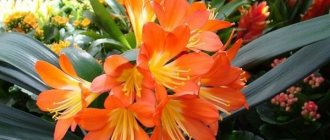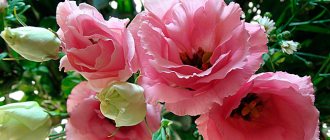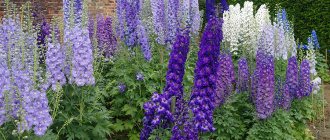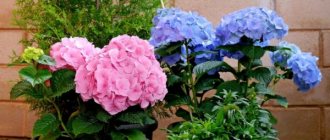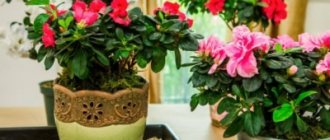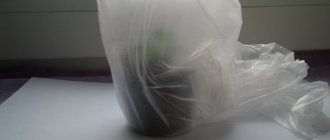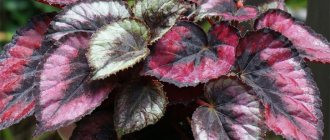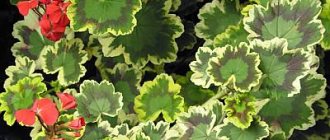This spectacular plant is one of the ten most popular ornamental flowers in home greenhouses. Having once seen Clivia, it is difficult to resist the desire to buy a blooming tropical beauty. An important fact is that Clivia begins to bloom in winter, when all the flowers are dormant. In addition, it is not whimsical and easy to care for, which means that any beginner can maintain it.
Flower named after a woman
Clivia is a stemless indoor evergreen plant with long, dark green leaves. The false stem is formed from basal leaves tightly covering each other. Homemade clivias reach a height of about half a meter, the flowers of the plant are collected in umbrella-shaped inflorescences with a diameter of about 20 cm. Flowering lasts about a month.
In nature, clivia grows up to a meter in height.
The name of plants of this genus was given by botanist John Lindley. The flower was named in honor of Duchess Charlotte Clive, the governess of the future Queen Victoria, who was fond of floriculture. And one of the varieties of clivia was called Clivia Gardena, named after Major Robert Garden, who in the mid-19th century discovered a new species and brought it to Europe.
Clivia belongs to the amaryllis family. Under natural conditions, it grows in the humid subtropical forests of South Africa.
In its homeland, clivia is often used for medicinal purposes. However, you should be extremely careful at home: the sap of the plant is poisonous. You should not use it for self-medication.
Amateur flower growers often confuse clivia and wallot. Both plants belong to the same family and have similar leaf and flower shapes.
Table: clivia and wallota - how to distinguish them?
| Sign | Distinctive features | |
| Clivia | Vallota | |
| Root system | There is no bulb as such, instead there is a white and thick, fleshy rhizome. | The bulb is elongated-ovoid in shape with a massive neck. |
| Leaves |
|
|
| Flowers |
|
|
| Juice | If the leaf is damaged, yellow-orange juice flows from the wound. | Deprived of this feature. |
In general, keeping clivia at home does not cause much trouble. But it is worth knowing about the most comfortable conditions for it in order to provide the plant with maximum decorativeness.
Clivia flowering
The leaves of the stemless plant are long, strap-shaped, dark green, overlapping each other at the base. Under favorable growing conditions, the crop produces 5-6 leaves per year.
A powerful peduncle develops from the center of a leaf rosette. Large specimens may have several of them at once. At the top of the peduncle, magnificent tubular or bell-shaped flowers are formed, which are collected in an umbrella inflorescence of 7-15 pieces, sometimes more.
The color depends on the type and variety of the plant.
Clivia usually blooms at the end of winter or the first month of spring and lasts several weeks. The plant may bloom a second time in summer or fall, but it will take about four months to recover.
Clivia fruits are red berries with large seeds.
Be careful when caring for indoor clivia, as the culture contains poisonous alkaloids.
Varieties
At home, three types of clivia are most often found: cinnabar, gardena and beautiful. Nevertheless, the flower is so good that new hybrid varieties are still being bred all over the world.
Table: distinctive features of various types
| Clivia variety | Peduncle height | Characteristics of flowers | Flowering time |
| Clivia cinnabar, or minium-orange (Clívia miniata) | 40–50 cm | Inflorescence in the form of a rosette with 10–20 flowers | February-May, but sometimes blooms at other times of the year |
| Clívia gardenii | 45–50 cm | 10–16 flowers | Second half of winter |
| Clivia beautiful, or noble (Clívia nobilis) | 30–50 cm | Inflorescence with 40–60 flowers | Second half of winter |
Clivia cinnabar turned out to be a very flexible plant, and on its basis more than a dozen new varieties with flowers of various colors were bred.
Photo gallery: Clivia cinnabar, also known as miniata, and other species
Clivia cinnabar blooms with bright orange-red flowers
A distinctive feature of Clivia Gardena flowers is their tubular shape and green tips.
Clivia Nakamura Red has bright red flowers.
Clivia citrina is a variety of Clivia miniata with creamy yellow flowers.
Clivia yellow is one of the hybrids bred on the basis of Clivia cinnabar
Clivia nobilis has drooping tubular flowers of red color with a white tip.
Reproduction
Seminal
Peculiarities:
- the fruits ripen in the ninth – tenth month after pollination;
- From November to April, collect orange clivia seeds and sow them in a mixture of equal parts of turf and sand. Take half as much peat;
- after a month or a month and a half, shoots appear;
- transplant the young plant into a small pot after the first leaf appears. Soil: peat, sand and humus - 1 part each, turf - 2 parts;
- as the flower grows, increase the size of the pot - up to 9–10 cm in the second year, up to 12–13 cm in the third;
- after six months there are already 4 or 5 leaves, in the second year another three to four pairs of wide, long leaves are added;
- in the third year in the fall for 2 months, be sure to provide peace, the correct temperature, and humidity: if the conditions are met, a third of the seedlings will bloom for the first time.
Vegetative and seed propagation is characteristic of the following plant species: “Hippeastrum”, “Water Lily”, “Hyacinths”, “Bat” (“Black Lily”), “Mouse Hyacinth”.
Vegetative
Recommendations:
- at home, use “babies” (shoots);
- when transplanting an exotic plant, carefully separate the shoots that have 4 or more leaves;
- for the growth of offspring, a mixture of equal parts of greenhouse, leaf and turf soil is suitable;
- overmoistening is unacceptable: from excessive watering, the transplanted “babies” easily rot;
- in two to three years, subject to the temperature regime and ensuring a dormant period, Clivia will definitely delight you with bright colors.
Briefly about the conditions of detention
Caring for clivia does not cause any particular problems for gardeners. The most important thing for active development and flowering is to provide the flower with diffused light and a reduced temperature for rest in the autumn-winter season.
Table: what does a flower need to grow?
| Season | Temperature | Light | Watering | Top dressing | Air humidity |
| Summer | 20°C to 25°C | It is better to place the plant outside in partial shade. | Moderate, as the substrate dries | 1 time every 2 weeks | For clivia, this parameter is not important, so the leaves are washed more for hygienic reasons. |
| Autumn-winter (rest period) | 12°C to 15°C |
| Limited, from 1 time per week to 1 time per month | Not required | |
| Winter-spring (from the appearance of the peduncle) | 20°C to 25°C |
| Moderate, as the substrate dries | 1 time every 2 weeks |
Features of seasonal care
Clivia is special in that its care depends on the season and growth activity. When the plant blooms (this is somewhere in the middle of winter - the beginning of spring, depending on the variety), it needs abundant lighting, sufficient watering, and regular feeding. During this period, the culture becomes very sensitive to cold air currents. It should be placed in a warm place without drafts.
In summer, clivia grows actively, but does not bloom. It also needs moderate watering, good lighting, and fertilizing. From the beginning of autumn the resting phase begins. The plant must rest and gain strength. Watering is significantly reduced and fertilizing is stopped. You don't need a lot of light. The pot can be placed in partial shade.
How to care
Clivia is a plant that does not require special skills from the gardener. To ensure its comfortable growth, it is enough to follow the rules of watering and fertilizing, as well as create certain conditions during dormancy.
Watering
Clivia is a plant that does not like high soil moisture. Therefore, it should be watered only after the earthen ball dries out. Excess water from the pan should be poured out . If you neglect this rule, the roots of the clivia may rot.
When the plant enters the resting stage and the temperature in the room is reduced, watering is practically stopped; it is enough to moisten the soil once every 10 days. After flower stalks form on the clivia, the plant begins to be watered again as the soil dries out.
Tap water must be settled before watering. It is important that it is soft enough, without chlorine.
Air humidity is not important for clivia. Therefore, there is no need to spray it with a spray bottle . However, the plant is responsive to removing dust from the leaves with a damp cloth.
About once in the summer you can wash clivia in the shower.
Top dressing
Clivia is susceptible to fertilizing. They help it develop intensively and make it more decorative in appearance. Feeding should begin from the first year of life in the summer . Clivia should be fertilized during the period of growth and flowering once every 2 weeks, alternating organic and mineral products .
It is best to use organic fertilizers based on vermicompost. This could be Ideal, Giant, Breadwinner and others. To use them, 1 tablespoon of fertilizer is diluted in 2 liters of water.
Mineral complexes are diluted in warm water in a ratio of 2 g of fertilizer per 1 liter. The most commonly used are Ammophos, Kemira, Nitrophoska.
After the rest period begins (approximately from the beginning of autumn), feeding should be stopped and resumed when the flower shoots out the peduncle.
Nitrogen-based fertilizers can delay flowering. And complexes with a high potassium content have the opposite effect, stimulating the flowering of clivia.
Flowering time
Clivia usually begins to bloom in late winter or early spring and lasts about a month. When the flower arrow has become high enough (more than 10 cm), you should end the rest period and move the flower from an unheated room to a warm and well-lit place .
During flowering, you should increase watering of clivia and fertilize it regularly. For irrigation, it is better to take warm water, at a temperature 3–4 degrees above room temperature. If you do not start care on time, the flower stalk will be short and the flowering time will be significantly reduced.
After the clivia is placed in a bright place, the pot cannot be rearranged or even rotated.
What to do to make clivia shoot out a peduncle and bloom
Usually, the flowering of clivia is prevented by lack of rest . If you do not reduce watering and lower the temperature in autumn-winter, it is unlikely that you will be able to make clivia bloom.
When the arrow appears, the plant should be washed with warm water from the shower, increase watering and begin fertilizing. The first feeding is high in potassium (potassium chloride, potassium salt, potassium sulfate).
For the first time, clivia grown from shoots blooms in the second or third year. If propagation was carried out by seeds, the appearance of flower stalks should be expected no earlier than the fourth year of life.
If clivia does not bloom by this time, it needs a long rest. To do this, the plant is transferred to a low-light place with an air temperature no higher than 16°C for 3–4 weeks.
Another reason for the lack of flower stalks is that the pot is too spacious: the clivia will not bloom until the roots fill it completely.
When the clivia has faded and the peduncle is cut off: dormant period
It is important for Clivia to create conditions for rest in the winter. At this time, you can take the flower pot to a glassed-in loggia or another cool room. The main thing is that the air temperature should not be below +12°C, otherwise the plant may die.
The older the clivia, the more time it will take to rest. It is enough for young plants to rest for two months - from the end of September to November. When the age of the flower exceeds five years, the dormant period should be increased. From this moment on, clivia needs rest throughout the autumn-winter period - from mid-September to early February.
The rest period ends when the peduncle appears.
Can a plant bloom twice a year?
It is better to move the faded clivia to fresh air - a balcony or garden. The place for the plant should be shady and windless.
If you want to get the plant to bloom again this year, after a short break in nature, you should take the clivia to a low-light place and stop fertilizing, and also reduce watering to once a month. The leaves may begin to turn yellow, but there is nothing to worry about. In about a month, expect a new arrow to appear.
You can achieve flowering twice a year only from an adult and healthy plant.
Planting and caring for clivia
- Flowering: about a month in late winter or early spring.
- Lighting: bright diffused light (western, eastern or northern window sill).
- Temperature: 20-25 ˚C during the growing season and 12-15 ˚C during the dormant period.
- Watering: moderate, between waterings the top layer of the substrate should dry out.
- Air humidity: does not matter.
- Feeding: during the period of growth and flowering every 2 weeks with mineral or organic fertilizers.
- Dormant period: from October or November for one and a half to two months.
- Replanting: young - annually, adults - once every 2 or 3 years, large specimens are not replanted: the top layer of substrate 5 cm thick in their pots is replaced annually.
- Reproduction: seed and vegetative (by lateral shoots).
- Pests: aphids, scale insects, mealybugs.
- Diseases: gray rot, staganosporosis, root rot.
Read more about growing clivia below.
Clivia flower , or Kaffir lily, belongs to a small genus of evergreen herbaceous perennials of the Amaryllis family. In nature, clivia flowers grow on the west coast of South Africa and are represented by only three species. As a houseplant, clivia attracts with its beauty and ease of care. Indoor clivia is beautiful both during flowering and during the dormant period, since not only the bell-shaped flowers of the plant are beautiful, but also its juicy dark green leaves.
Clivia is a plant of the Sagittarius sign, so for those born under this zodiac sign, it helps to maintain a love of life and protects them from negative influences.
Errors in care
Despite the fact that Clivia is not capricious, various troubles can sometimes happen to it. It is important to know why they appear and how to correct them.
Table: why the tips dry out, the leaves turn yellow, brown spots and other visible defects appear
| External manifestation | Causes | What to do |
| The leaves are turning yellow | Natural aging, when old leaves die and new ones grow in their place | Does not require any measures |
| Insufficient or excessive watering |
| |
| Little fertilizer | Fertilize during the flowering period once every 2 weeks. | |
| If the plant is pollinated, the leaves turn yellow due to the redistribution of nutrients from the flower to the fruit. | Remove the fruits and peduncle when it begins to dry out | |
| Concerns such as transplantation, transfer or drafts | Move the potty only if absolutely necessary | |
| Brown spots on leaves | Sunburn | Remove the plant from direct sunlight |
| Pale leaf color | Lack of nutrition | Fertilize according to the rules |
| Leaves rot | The roots were damaged during transplantation | Watering is stopped until the earthen clod dries completely. |
| Brown tips of leaves | Excess moisture | Water more moderately, remove water from the pan |
How to plant a plant at home?
Clivia, as the owner of a complex and intertwined root system, finds it difficult to cope with transplantation manipulations; there is a high risk of rotting of the root system. Replanting the plant is required to renew the soil and to expand the size of the pot in accordance with the overgrown roots.
There are two ways to renew the soil and solve the problem of root fibers coming out of the soil: replanting and transshipment.
Transshipment is done once every two years immediately after the end of the flowering period; this is typical for caring for adult clivia.
For young flowers, transshipment is done annually. When transshipping, the plant is carefully dumped out of the old pot along with a lump of earth. Take the pot a little wider and roll the plant there, increasing the volume of soil and without destroying the integrity of the soil coma, which is entwined with the roots of the clivia. If we are talking about the first two years of the plant’s life, then add a little ripper in the form of sand or perlite to the top layer.- When replanting, the root system is completely freed from the soil and covered with new soil.
Important! For old clivias, replanting is not recommended; it is advisable to simply renew the upper part of the soil annually, the thickness of the new layer is up to five centimeters. To do this, take loose soil with weak acidity - a couple of parts of turf with one part of peat and one part of compost.
Diseases and pests
Pests rarely bother clivias, but in order to deal with them, it is important to notice the onset of an attack in time and prevent them from multiplying. If there are too many pests, it will be very difficult and sometimes pointless to fight them. The most common enemies of clivia are scale insects and mealybugs, rot .
The scale insect, also known as the shield aphid, has a protective waxy shield that protects the body of the pest. Adult aphids are motionless, but the larvae can crawl throughout the flower. Mealybugs form colonies.
Photo gallery: enemies of clivia
A sign of scale insects is red sticky spots and brown plaques on the leaves.
Mealybug forms a cottony coating on the leaves
The most common disease of clivia is rot.
Table: flower treatment for diseases and pests
| View | What does it look like | What to do |
| Scale insect (shield aphid) | Dark spots-growths on leaves | The larvae are destroyed by washing the flower with a soap solution (a small amount of kerosene or denatured alcohol can be added to it for effectiveness). Adults are removed with a damp soapy swab, but after this the plant must be sprayed with an insecticide. |
| Mealybug | Looks like white cotton wool on the leaves | A small number of pests can simply be removed with a damp swab, but if there are too many of them, it is necessary to spray the clivia with an insecticide weekly until recovery. |
| Rot | The leaves turn yellow, the plant begins to die | The reason is most often damage to the roots, so damaged roots should be cut off, the sections should be sprinkled with crushed coal and the plant should be transplanted into new soil. |
Soil contamination is the most common cause of pests and diseases, so do not forget to disinfect it before planting or replanting.
What to do after the petals have withered?
What to do with the clivia peduncle after flowering? At the end of this period, dry, withered flowers remain on the plant, which do not fall off for a long time and do not crumble under light mechanical stress. That is why, for fear of harming the plant, flower growers are wondering what to do with the peduncle when the clivia has faded? The answer is simple. You need to arm yourself with scissors and carefully trim the flowers.
The main thing when pruning is not to touch the standard . If damaged, the plant is more vulnerable to diseases. When the kaffir lily has completely bloomed, and there is no need to wait for the fruits to ripen, then you need to cut off all the ovaries. You should wait until the inflorescence stem dries, and then carefully remove it from the leaves. A dry, withered stem can be easily pulled out without harming the plant.
After flowering, clivia begins a dormant period, which means that it requires minor changes in care, namely:
- Reducing the number of waterings.
- Elimination of drafts.
- More frequent moistening by spraying or wiping with a damp cloth.
You should not feed the kaffir lily during the dormant period , as this will further deplete the plant.
Reviews from flower growers
My flower calmly tolerates all changes, although I read that he does not like to be moved. I water like everyone else - once a week in winter, twice a week in summer. I try not to overfill. Universal fertilizer. Periodically you need to wipe the leaves from dust. Not only because the plant looks ugly, but also because it is harmful for it. You can sometimes spray, but this is not important. My mother and I have clivias that live for 5-6 years, mine has been blooming for 3 years, but for some reason it still hasn’t for her. This is a mystery to us.
Bastet
https://citykey.net/review/kliviya-krasivyy-komnatnyy-tsvetok
...Clivia is an almost problem-free flower! Clivia can bloom with yellow-white, bright orange or red flowers, somewhat reminiscent of bells. And these flowers are not single, but are in inflorescences, often there are about thirty flowers at once! Extraordinary beauty! This plant does not require moisture, only sometimes I spray its leaves and wipe them to remove dust. But when clivia blooms, it is better not to move or rotate the pot with it at all. And replanting should only be done when the roots are visible from the drainage holes below.
Murmur
https://spasibovsem.ru/responses/tsvetok-s-krotkim-nravom.html
Hello, my dear flower lovers! The other day my orange beauty Clivia blossomed. She is so bright and sunny! Twice a year it pleases me with its flowering. She “lives” on the balcony. Only in the hot summer months do I bring it into the room and place it on the windowsill.
irulchik
https://myfl.ru/category/nazvanie-rasteniya/kliviya-0
They gave me this flower for my birthday (7 years ago). I generally love flowers, but this one immediately sank into my soul, thanks to its stunning flowers. Over the years, I have independently determined how to properly care for him, since there are some subtleties in this. So, tips for caring for clivia: 1) It likes watering only when the soil dries out... 2) When a peduncle appears, it is advisable to water it a couple of times with warm water (about +40 +50 degrees) - this will help the peduncle grow higher and rise above sheets. 3) After it flowers, wait 2-3 weeks and cut off the peduncle - this is important!!! - replant the flower. Take it out of the pot, cut off the roots a little (I cut it with a knife)... If you do this, I guarantee that your flower will bloom for the second time in a year! 4) Location - east window only. On other sides of the world it grows worse and may not bloom at all. Flowering, by the way, lasts almost 20–25 days. For me - once every six months. And he also gives children. Definitely recommend!
vergo
https://irecommend.ru/content/moe-oranzhevoe-chudo-0
Price
Clivia looks spectacular when in bloom. Fan-shaped leaves attract attention. The flowing, long, belt-like leaves look attractive, as does the flowering plant.
Beauty is expensive, especially natural. The flower will attract attention both in a luxurious mansion and in a small apartment. It is appropriate everywhere. In a small room it does not look defiant, but even in a vast mansion it will not get lost among its green brothers.
This exquisite flower looks in its place everywhere. You can buy the plant in flower shops, the price ranges from 450 rubles. up to 1000 rub. it all depends on the variety and condition of the specimen; the price of an adult plant is indicated. Baby clivias are sold at prices starting from 80 rubles. up to 120 rub. for the sprout.
The variety and beauty of home flowers often baffles flower growers. How many varieties and types. I want to buy a lot of flowers, but when I see clivia, all doubts disappear. There is no longer a question of what to buy. Only clivia. And don’t let caring for clivia at home scare you, it’s not capricious and won’t take up much of your time.
Video: clivia - unpretentious beauty in the house
Charming clivia blooms in winter, when we so lack bright colors. Its flowers are spectacular and exquisite, so it is worth having an African beauty at home, especially since the plant is unpretentious in care and can delight you with abundant flowering every year.
- Author: Olga Isakina
Good afternoon I am Olga. I am 40 years old. Rate this article:
- 5
- 4
- 3
- 2
- 1
(3 votes, average: 5 out of 5)
Share with your friends!
Care Tips
Features of watering and fertilizing
The plant does not like excessive moisture, so moderate watering is needed. Moisten the soil only after the top layer of the substrate in the container has dried. Clivia itself warns that if you overdo it with watering, the tips of the leaf blades become brown and the base begins to rot. Stop watering the plant, and when the soil is completely dry, start watering the clivia according to the rules.
Moisten the substrate once a week with soft water. To do this, you need to boil tap water and let it sit for 24 hours. During the formation of buds, the amount of watering should be increased. Do not allow excess moisture; if water appears in the pan during watering, be sure to pour it out.
For clivia to bloom brightly and abundantly, it requires large amounts of both mineral and organic substances. Alternate the application of different types of fertilizers every two weeks during the spring and summer. Do the last feeding a month before the “sleep” period - in early September.
Add fertilizer to irrigation water
Good results are achieved by using complex fertilizers for flowering plants, for example, Fertika or Agricola. Biohumus is suitable for adding organic matter to the soil. Add a few drops of liquid fertilizer to water for irrigation or a teaspoon of granular fertilizer per 2 liters of water (the concentration of different products varies, so follow the manufacturer's instructions on the package). Apply fertilizer only to moist soil, otherwise you may burn the tender roots of the clivia.
Rest period
During the resting period of clivia, which begins around October, feeding the plant is not required. You should also reduce the frequency of watering several times; moisten the soil only if absolutely necessary, if the earthen ball is completely dry. This period lasts differently; the older and larger the plant, the longer the rest period it needs.
The older and larger the plant, the longer the rest period it needs.
Clivia flowering period: how to make an African beauty bloom
To obtain abundant flowering, a dormant period of one to two months is needed. The plant itself will tell you when it is over: the clivia will throw out the peduncle. This moment cannot be missed, since for clivia to bloom, it is necessary to create additional conditions.
First, increase the temperature to + 20°C. Secondly, the number and volume of watering should be increased, avoiding stagnation of water. Clivia does not like to be disturbed, turned or moved during the flowering period. Therefore, all of the above procedures should be done before the buds begin to appear.
Clivia typically blooms in January or February and lasts approximately three to four weeks.
If flowering never occurs or the growth of the peduncle has stopped, it means that you did not provide your beautiful clivia with coolness and partial shade during the “sleep” period. The situation can be improved. To do this, move the clivia to a cool, shady place for a month, and it can bloom even in spring.
The second reason for the lack of flowering is that the container in which the clivia is planted is too spacious. Wait until its roots completely entwine the earthen ball, and the plant will definitely delight you with abundant flowering, but already in the next season.
When the clivia has faded, cut off the peduncle and give it another short rest period; move it to a cool but bright place, for example, to a glazed loggia. With the onset of spring, start feeding the plant. The place for keeping clivia at this time should be warm with a temperature of approximately + 25°C.
Clivia blooms for about a month
Table: mistakes that flower growers make in care, and how to correct the situation
Flower growers consider clivia to be a rather unpretentious plant, but despite its unpretentious conditions, it can suffer from improper care.
| Sign | Cause | How to fix |
| The leaves turn yellow and dry out. | Natural aging process. | There is no need to take any measures, new ones will grow instead of dead leaves. |
| Lack of watering or excess watering. | Remove the plant from the pot and check the roots. Replant the clivia by removing the rotten roots and reduce the amount of watering. | |
| The plant does not feel well after being moved to a new location or as a result of transplantation. | Try not to disturb the plant (or do it as little as possible), and do not turn or move the clivia to another place during the flowering period. | |
| Brown or light-colored spots appeared on the leaf blades. | Clivia got a sunburn. | Shade the flower from direct sunlight. |
| The leaves are pale green. | Insufficient nutrition. | Fertilize regularly, alternating organic and mineral complex fertilizers. |
| Leaf blades rot | The roots were damaged during transplantation. | Stop watering until the potting medium is completely dry. After 1-2 days, resume watering, carrying out the procedure correctly. |
| The tips of the leaves turn brown. | Excess moisture. | Reduce the number and volume of watering. |

